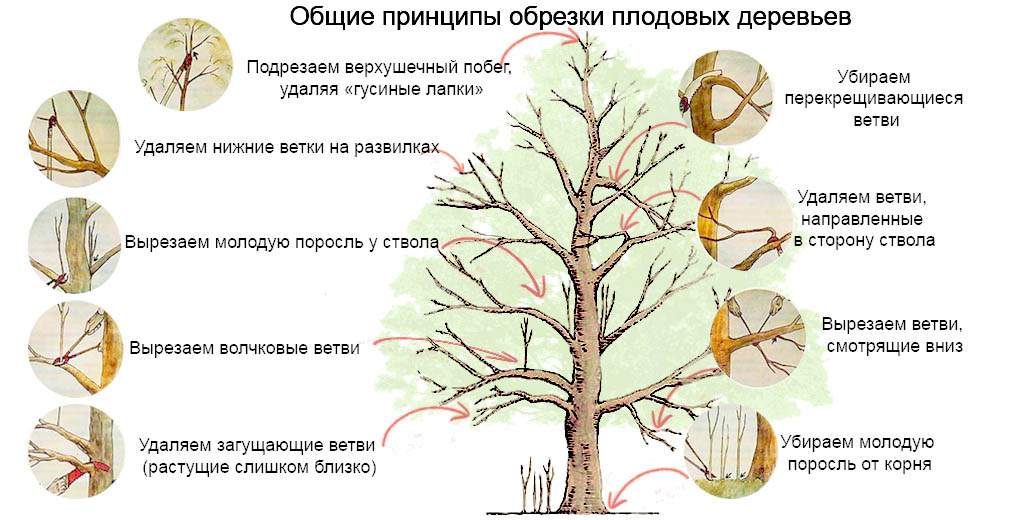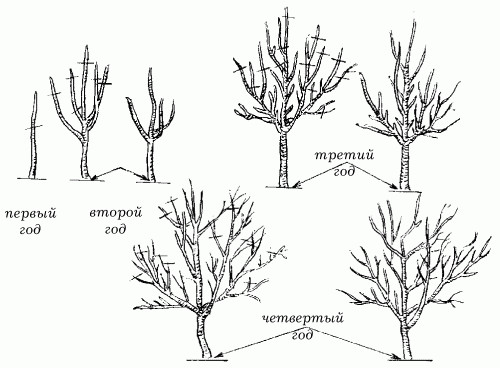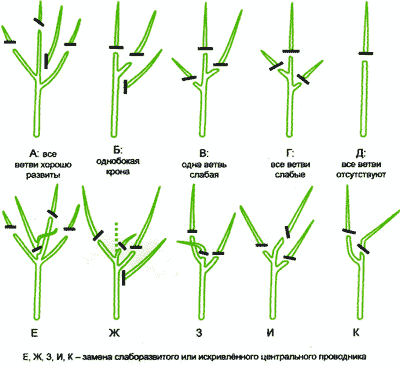Instructions for pruning old and young apple trees in spring
Content
Spring pruning features
Like the other three seasons, spring has its own specific characteristics that must be taken into account when processing the garden and preparing it for the future fruit set. The most important thing to remember when pruning apple trees in spring is the active circulation of juice along the trunk of an individual. Therefore, you need to be very careful not to harm the tree or ruin it.
Crown formation
It is worth immediately deciding what ultimate goal you are pursuing before starting to remove some of the branches and shoots. If in the future you want to see a healthy apple tree in your country house that gives good yields and a well-groomed, beautiful tree, then, first of all, you need to form the crown of an individual.
Before you start pruning, you need to identify the branches that have suffered during the winter. This will be done without problems, since it is easy to distinguish dead parts from healthy ones by swollen kidneys. This is the first step in the formation of the crown of the apple tree and in the recovery of the entire individual. For such crops, experts recommend a bushy form, with several main, skeletal branches and additional branches. This option, firstly, will make the tree itself more stable and will not allow it to deform under the weight of the fruit, and secondly, it will allow you to harvest this crop without the slightest effort. In addition, proper pruning and caring for an individual will extend its life for many years.
Fast recovery
The earlier in the spring you start cutting too much on your apple tree, the faster it will recover from stress and prepare for fruiting. The main thing is to remove dead, old or excess branches at an angle from the trunk or skeletal branch. This statement is also true for columnar varieties. The cut is recommended to be covered with mastic intended for garden work or oil paint, for lack of special tools. This is the right approach as it will keep the tree sap from flowing out of the cut and leave it in the trunk itself. So the apple tree will recover faster and, possibly, by the same autumn will bear fruit.
Video "Spring pruning of apple trees"
After reading the videos, you will understand all the principles of spring apple pruning in details.
Differences in pruning old and young apple trees
It is not surprising that the scheme for eliminating excess shoots on the trunks and skeletal branches of young and old trees during spring pruning of apple trees is significantly different, but, at the same time, has common roots. Trees that have not yet borne fruit or have yielded one or two crops are pruned in special ways and more often than more mature individuals.

Young trees
In spring, newly planted seedlings need basic crown formation.If you miss this moment from the very beginning, then later it will be more difficult to achieve the optimal shape and height of the trunk. The optimal view is a sparse crown and branches in several tiers. In the future, the procedure will need to be repeated annually for three to four years. After - every two years. This procedure, carried out in the spring, will allow the apple tree to fully develop and improve its yield several times. There will be no need for additional support, since the structure of the seedling will be self-sufficient and will not need support. In general, gardeners recommend pruning and forming a base of several large branches (5 or 6). The stem should be 40 or 50 centimeters high in height. The central trunk branch must be shortened so as not to spoil the crown.
Old trees
When a fruit crop has been living on a site for several years and does not give the proper harvest, then the owner of this site should think about whether it’s time rejuvenate "Stalled" tree. There can be several reasons for this withering away: a lot of extra shoots that hamper the development of fruits, lack of sufficient sunlight, an improperly formed crown or excess dead twigs. All these factors affect the life of apple trees, especially when some of them complement each other.
Before pruning, it is first of all recommended to clear the main branches and trunk from the shoots growing inside. It is they who take the life force from the individual.
The upper part of the branches with the help of thinning must be given the opportunity to ventilate and access sunlight. In this way, you can save those apple trees that have been growing on the site for more than twenty, or even thirty years. Moreover, you can make them bear fruit for many more years. To do this, you need to cut off a little less than a third of the total mass of branches and shoots. Prepare to do this for two or three years, until the result appears and the "patient" begins to bear fruit or actively bloom.
The main thing in this business is not to overdo it. If the liquidated mass is more than the recommended one third, then this is fraught with consequences. In this case, it will be impossible to save the tree, the only thing that remains is to cut it down at the root or assign a decorative role in the country.
Tools
Experts and amateurs unanimously declare: when eliminating dry, excess or diseased branches, only sharp hacksaws, pruning shears or saws should be used. One of the main requirements is a clean blade, free of rust and foreign substances. Otherwise, any cut or stump on the trunk or branch can "fester" and strike the entire tree with a disease, thereby destroying it.
A "live" cut needs insulation (if it is a small stump) or a substance to prevent the outflow of tree sap. In addition to garden mastic and oil paint, ordinary children's plasticine can be used for these purposes. It is better, of course, to choose the least bright color - it is less stuffed with chemicals and will bring less harm to the “patient”.
In general, the main thing is to adhere to the basic rules prescribed by experts for pruning trees, and fruit trees in particular. However, if you are not confident in your abilities and skills, consult with specialists. Better yet, invite them for help. The first time it is better to observe the actions of an experienced person, the next - you can already do all the manipulations yourself.
Video "How to process an apple tree after pruning"
We make a talker to putty the cuts after pruning fruit trees.


